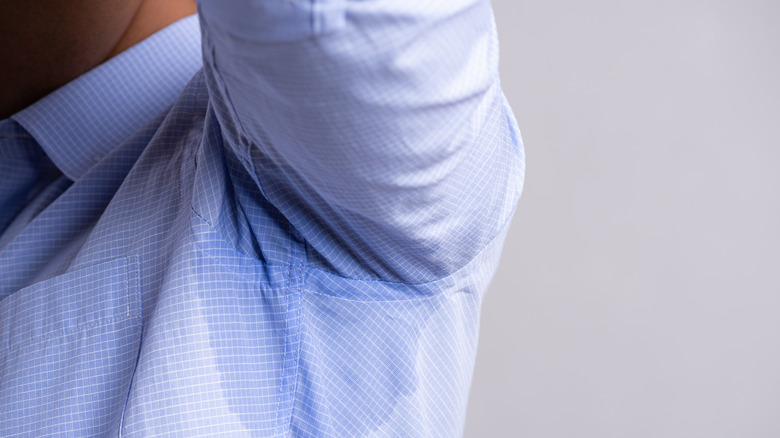The Rare Condition That Can Make Your Toilet Seat Turn Blue
A sweat-stained T-shirt is a nightmare. No amount of scrubbing, baking soda, or rinsing can get those stains out. Once they set, they are set in stone. A professional dry cleaner can get them out, but short of that, those yellow stains are there to stay. Thankfully, sweat stains are fairly light and, on some shirts, are almost impossible to see.
Of course, that wouldn't be the case if the sweat were green, or worse, dark blue. Worse still, imagine those stains showing up in other places. Places like your mattress, your car's upholstery, and even your toilet seat. Bathroom business is personal enough without wondering why your toilet seat is slowly turning blue.
It might sound like something out of a movie, but it can actually happen. Instead of the colorless sweat most people are used to, there are people out there who sweat in a variety of colors ranging from blue to green to red to bright yellow. While some colors are caused by external compounds, some are the result of a natural body process gone awry. They are caused by a condition known as chromhidrosis. It's incredibly rare with so few known patients that despite appearing in medical literature since 1709, there is almost no demographic information available (via StatPearls).
Chromhidrosis explained
Dr. Dustin Wilkes and Dr. Shivaraj Nagalli, have written a comprehensive guide to chromhidrosis. They explain that there are three types of chromhidrosis. The first, apocrine, occurs anywhere there are apocrine glands. These are the areas most people think of when they think of sweaty spots, specifically the underarms and the genital region among others (via StatPearls).
When chromhidrosis occurs in these spots, it is due to a high concentration of oxidized lipofuscin. As LiveStrong explains, all apocrine glands contain lipofuscin. It is generally yellow-brown in color and causes the kind of staining we're used to seeing on gym clothes. Concentrated and oxidized, however, it turns either greenish-brown or blackish-blue, dying the sweat from those areas.
Dr. Wilkes and Dr. Nagalli go on to explain that the second kind of chromhidrosis is called eccrine. Eccrine chromhidrosis can occur anywhere since eccrine glands are found all throughout our skin (via StatPearls). This form of chromhidrosis is typically caused by something like dye or heavy metals getting into the body's internal systems and dying the sweat artificially. It's related to the third kind of chromhidrosis, pseudochromhidrosis, which occurs when the sweat comes out the proper color but changes when it reacts to something on a person's skin (via LiveStrong).
Both eccrine and pseudochromhidrosis can be treated but apocrine is considered a chronic condition. It usually manifests in childhood and improves with age as natural lipofuscin production goes down. However, there is currently no cure and the condition is so rare researchers aren't sure how soon they will be able to find one.


